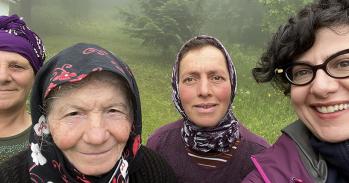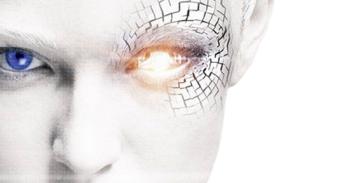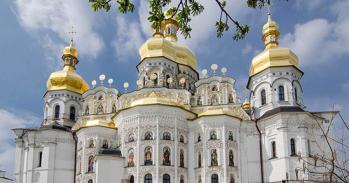An endangered Greek dialect spoken in Turkey has been identified by Dr Ioanna Sitaridou as a "linguistic goldmine" because of its closeness to a language spoken 2,000 years ago.
An endangered Greek dialect spoken in Turkey has been identified by Dr Ioanna Sitaridou as a "linguistic goldmine" because of its closeness to a language spoken 2,000 years ago.
Although Romeyka can hardly be described as anything but a Modern Greek dialect, it preserves an impressive number of grammatical traits that add an Ancient Greek flavour to the dialect’s structure – traits that have been completely lost from other Modern Greek varieties.
Dr Ioanna Sitaridou
Until Medieval times, the area of Trabzon, on the Black Sea coast of Turkey, lay at the heart of the Greek-speaking world. The land of the legendary Amazon kingdom was colonised by the Greeks in the 8th and 7th centuries BC and was immortalised in Greek mythology as the area from which Jason and his crew of 50 Argonauts began their journey across the Black Sea on his quest for the Golden Fleece.
Remarkably, despite millennia of change in the cultural and socio-political history of the surrounding area, in this mountainous and isolated north-east corner of Asia Minor its people still speak Greek. The uniqueness of the dialect – known as Romeyka – is providing a fascinating window on language past and present, as Dr Ioanna Sitaridou, University Lecturer in Romance Philology at the Faculty of Modern and Medieval Languages and Fellow and Director of Studies in Linguistics at Queens’ College, is discovering.
On the verge of extinction
Romeyka is proving a linguistic goldmine for research because of the startling number of archaic features it shares with the Koiné (common) Greek of Hellenistic and Roman times, spoken at the height of Greek influence across Asia Minor from the 4th century BC to the 4th century AD.
‘Although Romeyka can hardly be described as anything but a Modern Greek dialect,’ explains Dr Sitaridou, ‘it preserves an impressive number of grammatical traits that add an Ancient Greek flavour to the dialect’s structure – traits that have been completely lost from other Modern Greek varieties.’
As devout Muslims, Romeyka speakers in the Trabzon area were exempt from the large-scale population exchange between Greece and Turkey following the Treaty of Lausanne in 1923. Using religion as the defining criterion to re-settle Christians in Greece and Muslims in Turkey, the Treaty resulted in the exchange of some two million people between the two countries. For Pontus, the result was an exodus of Greek-speaking Christians, leaving small enclaves of Greek-speaking Muslims in Turkey.
Repeated waves of emigration from Trabzon, coupled with the influence of the dominant Turkish-speaking majority, have left the dialect vulnerable to extinction (UNESCO have designated Pontic Greek as ‘definitely endangered’). ‘With as few as 5,000 speakers left in the area, before long Romeyka could be more of a heritage language than a living vernacular,’ says Dr Sitaridou. ‘With its demise would go an unparalleled opportunity to unlock how the Greek language has evolved. ’
Language cartography
Dr Sitaridou’s research project is uncovering the secrets of this little-studied dialect. Her expertise is both in syntax, which is the study of a language’s grammatical rules and sentence structure, and in how and why language changes. ‘With Romeyka, I have the most wonderful opportunity to study these two things in tandem. Not only does the dialect demonstrate elements that are proving problematic for the current linguistic theory but it also presents us with a living example of an evolving language.’
In collaboration with Professor Peter Mackridge (University of Oxford), who has carried out pioneering research on Pontic dialects since the 1980s, Dr Sitaridou is also working with Dr Hakan Özkan (University of Münster), Professor Stavroula Tsiplakou (Open University of Cyprus), the European Dialect Syntax network (Meertens Institute) and three postgraduate students: Stergios Chatzikyriakidis, Petros Karatsareas and Dimitrios Michelioudakis.
At the core of her work are fieldtrips to villages in Pontus to map the cartography of the language – how it works, how much micro-variation there exists (known as synchrony) and how the morpho-syntactic structure has changed through time (diachrony). Information is gathered through video and audio recordings of the villagers telling stories, as well as through specially structured questionnaires that Dr Sitaridou has designed to collect the complex data needed for unpicking the structure of a language.
Window on the past
Studying language change is, in general, notoriously difficult because of the lack of living speakers who can positively tell us what they think is ungrammatical or not (in contrast to texts, from which we can only recover what is grammatical). Investigating the history of Greek is no different despite the plethora of old texts.
‘Imagine if we could speak to individuals whose grammar is closer to the language of the past; not only could we map out a new grammar of a contemporary dialect but we could also understand some forms of the language of the past. This is the opportunity that Romeyka presents us with,’ says Dr Sitaridou, who is also a member of the Cambridge Group for Endangered Languages and Cultures (CELC).
Last of the infinitives
The first results of the study are already providing remarkable insights, as Dr Sitaridou announced during the first ever linguistics conference on Romeyka last March at Queens’ College, Cambridge: ‘Unlike ancient forms of Greek, use of the infinitive has been lost in all other Greek dialects known today – so speakers of Modern Greek would sayI want that I goinstead ofI want to go. But, in Romeyka, not only is the infinitive preserved, making this essentially the last Greek infinitive of the Greek-speaking world, but we also find quirky infinitival constructions that have never been observed before – only perhaps in the Romance languages are there parallel constructions.’
All the more astonishing, the results so far seem to be indicating that Romeyka is closer to Hellenistic Koiné than all other Modern Greek dialects, which are generally considered to have emerged from the later Medieval Greek spoken in the 7th to the 13th century AD.
Change ‘in real time’
Dr Sitaridou’s research is ultimately trying to pinpoint how Pontic Greek evolved. ‘We know that Greek has been continuously spoken in Pontus since ancient times and can surmise that its geographic isolation from the rest of the Greek-speaking world is an important factor in why the language is as it is today,’ says Dr Sitaridou. ‘What we don’t yet know is whether Romeyka emerged in exactly the same way as other Greek dialects but later developed its own unique characteristics which just happen to resemble archaic Greek. Or whether it developed from an earlier version of Greek in contrast to the rest of the Greek dialects and as a result of this more direct lineage, as well as its isolation from other dialects for centuries, it maintains archaic features.’
Nevertheless, Romeyka also demonstrates considerable innovation especially as a result of contact with Turkish. In this respect, Dr Sitaridou is interested in modelling what influence the contact with Turkish and Caucasian languages has had on the evolution of the dialect. Given the linguistic and socio-historic context of Romeyka, she notes that ‘in Pontus, we have near-perfect experimental conditions to assess what may be gained and what may be lost as a result of language contact.’ It is precisely these questions she will pursue further as the recipient of the prestigious Stanley J. Seeger Visiting Research Fellowship in Hellenic Studies at Princeton University in Spring term 2011.
The implications of such research are, however, far more pervasive, since understanding how language functions could provide some insight into cultural identity and people’s sense of themselves, as well as what happens when cultures connect.
Dr Sitaridou, whose own great-grandparents were from the region, believes that the linguistic evidence will help to unravel the thread of language evolution; we have yet to see whether the thread takes us all the way back to the time of Jason and the Argonauts and whether more surprises await us.
For more information, please contact Dr Ioanna Sitaridou (is269@cam.ac.uk; http://people.pwf.cam.ac.uk/is269).
Cambridge Group for Endangered Languages and Cultures
Linguists and anthropologists from across Cambridge have created Cambridge Group for Endangered Languages and Cultures (CELC) as a forum for researchers with common interests not just in seeking to document languages that are under threat, but also the literatures and ideas about cultural identity that they help to maintain. For more information, please visit http://groups.pwf.cam.ac.uk/celc/
This work is licensed under a Creative Commons Licence. If you use this content on your site please link back to this page.





